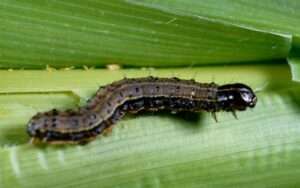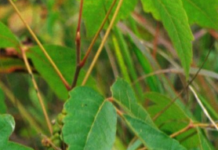By: Scott Eckert, Harvey County Extension Agent, Horticulture
The fall army worm is back! I have had numerous questions about them and by the time you read this we should be near the end of their feeding and damaging cycle. We generally have them each year here but rarely in a population like we are seeing now. The good news is they rarely kill the lawn and they only feed for a few weeks.
What do they look like? Young worms are ½- to ¾-inch long. Mature ones are 1 1/2 inches long. Body color may vary from green to almost black but light stripes will be visible along the length of the body. Look for a whitish inverted “Y” on the top of the dark colored head.
Fall armyworms are a tropical insect species. As such, only southern Florida and southern Texas afford mild enough wintertime temperatures to assure their survival. In fact, fall armyworm activities are continual in overwintering areas. Of course, fall armyworms also overwinter in their native ranges of Mexico, Central America and South America. Seasonal fall armyworm activities in non-overwintering areas begin with egg-laying activities of the moths moving northward out of their native ranges. Once established, additional generations can occur every 23-25 days. Thus, in central Texas, they experience 7 generations of fall armyworm each year, while in Kansas, 2-4 is a more likely number, and depends on when initial flights moved into Kansas.
Female fall armyworm moths have the ability to produce approximately 1000 eggs which they deposit in clusters containing up to 400 eggs each. Larvae produce a silken thread which allows them to drop or be blown to their food source. Smaller larvae will do superficial feeding, while larger larvae cause more extensive damage. Damaged grasses may become withered and brown. Under large populations, the appearance of “browned areas” occurs in very short order (24-hours or less). However, fall armyworms seldom kill grass —- rather, than nubbing a plant down to the crown and growing point, larvae will select a more tender adjacent grass blade to feed upon. Of course, under heavy feeding pressure, larvae may be forced to feed deeper down on a plant, but usually, when the food supply becomes scarce or “tough”, the larvae will move “in mass” to adjacent areas where there is a “fresh stand” of food to feed on. Thus, having moved on and given that they usually do not “eat plants into the ground”, a flush of new growth restores the appearance of the turf. Rain and/or irrigation will help to speed up the regrowth process.
What can you do to? If insecticide applications are considered, carbaryl (Sevin), cyhalothrin (Spectracide Triazicide), permethrin (38 Plus Turf, Termite & Ornamental Insect Spray; Lawn, Garden, Pet, & Livestock Insect Spray; Eight Yard & Garden RTS), spinosad (Conserve, Monterey Garden Insect Spray, Captain Jack’s Dead Bug Brew, Natural Guard Spinosad) and Dylox (BioAdvanced 24-Hour Grub Control) are commonly available materials registered for control of fall armyworm in turf. Spray treatments have greater and quicker contact efficacy than granular applications. Granular treatments require irrigation or rain to activate the insecticide from the dry granular carrier. Professional lawn care service personnel have access to additional materials (such as Scimitar and Deltamethrin) which may have more persistence than homeowner products.
Lawn grasses are the primary target but as of this column we have seen them on annual and perennial flowers, garden vegetables and a few shrubs.





